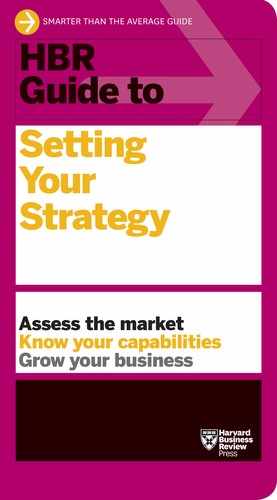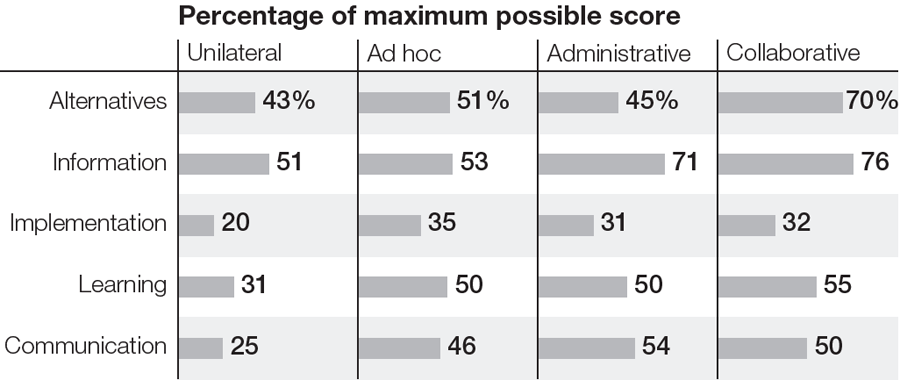CHAPTER 5
The Different Approaches Firms Use to Set Strategy
by Kimberly Teti, Mu-Jeung Yang, Nicholas Bloom, Jan W. Rivkin, and Raffaella Sadun
What is your strategy? Most senior executives can confidently answer this question.
How has that strategy changed over time? This one usually gets a quick answer too.
How do you make decisions about changing that strategy? Now it gets much more difficult.
The fact is, many senior executives struggle to describe how they make strategic decisions. That’s a serious problem, since the process for making strategic decisions can shape the strategy itself. Making a strategy without knowing your process is like sailing without a compass. You are setting yourself up for a long, stressful journey. Even worse, if you eventually reach your destination, you may not realize that you’re in the right place.
To better understand how companies really make strategic choices, we recently interviewed 92 current CEOs, founders, and senior executives. We asked each to answer detailed questions about their approach to strategic decision making. Their replies revealed both striking variety and underlying patterns. Here, we offer a typology of four approaches. Our results can’t say that any single approach to strategy is always best, but we do offer some evidence that one of the approaches is often flawed.
Four Approaches to Strategic Decision Making
Companies’ processes differed from each other in two ways. The first was whether a firm uses a high or low level of process to make strategic decisions. That is, does it have recurring routines for discussing strategy, triggering strategic changes, and reviewing those changes? The second was the amount of input from other employees that the leader considers while making a strategic decision. This factor focuses on employee involvement in decision making, not simply attendance at meetings or postdecision communication. These two factors can exist in any pairing, and based on our interviews, firms populate all boxes, which gives us four distinct archetypes of strategic decision making.
Four approaches to strategic decision making
Note: Based on interviews with 92 executives
Unilateral firms are both low process and low input. They tend to have a top-down leader who makes decisions alone. During our interviews, these individuals often had difficulty explaining their decision-making process and the role other employees played. Interestingly, these interviewees had two different types of attitudes: Some disliked their process and admitted that they should do things differently, while others seemed very confident with how they made decisions. A potential benefit for unilateral firms is that leaders can make decisions quickly, without the constraints of process complexity and debate. However, lacking checks and balances, unilateral firms can make bad decisions fast. Moreover, speed is not a sure thing in a unilateral firm: If the top-down leader chooses to procrastinate on a tough decision, no process is in place to force timely action.
Ad hoc firms are low process and high input. These firms do not have a codified, recurring process that they follow every time they make a strategic change. But when a change needs to be made, the leader pulls their team together to take action. The exact steps the firm follows and the exact people in the room change from one decision to the next. The benefit of an ad hoc system is that rigid rules don’t constrain the firm. Leaders can tailor the process to each decision by adjusting the length of deliberations, the involved parties, and other factors. The main risk is that the firm may not learn over time how to get better at making strategic decisions. The top leader of an ad hoc firm might also use the process flexibility to exclude stakeholders who disagree with the leader’s position. This will eliminate the debate that fuels ad hoc decision making, and, in essence, shift the firm down to the unilateral box.
Administrative firms are high process but low input. These firms follow rigorous processes and well-defined routines to make strategic decisions without actually eliciting debate from other employees. One benefit is the detailed data collection and documentation that accompanies this extensive process. If administrative firms are smart, they can leverage this information to improve future decision making. But, similar to unilateral firms, the low level of input can result in bad decisions if leaders do not consider key information or opinions. In fact, this risk can be especially grave in administrative firms because the detailed process and the sheer quantity of information gathered can act as theater, masking the lack of broad input from internal and external stakeholders.
Collaborative firms are both high process and high input. These firms have the rigorous process of an administrative firm, but also the engaged employees of an ad hoc firm. During interviews, these leaders showed strong consistency across different types of decisions and could clearly articulate how employees added value during the process. The detailed process ensures that the leaders don’t miss any steps. The frequent input ensures that they don’t miss any information. However, the inflexible system can potentially slow down decision making and prevent firms from acting on time-sensitive opportunities. For example, collaborative firms may inadvertently include irrelevant parties in strategy discussions or spend too much time achieving consensus among the participants in order to maintain engagement.
Which Approach Should a Firm Use?
Each of these archetypes has benefits and risks, which invites a question: Where should a firm sit in the matrix? Our interview data shows tremendous variation in archetype within each industry and across firms of similar size, which suggests that the right archetype for a given firm depends on subtle features of the company and its context. Our current research does not include enough data on context and firm performance to pinpoint the conditions in which one archetype would be the winner.
That said, our early data does make us skeptical about the unilateral archetype. In our interviews, we asked managers to give us a sense of where their approach stood in terms of five attributes that are generally associated with good strategic decision-making processes, namely:
- Alternatives. Does the firm consider alternative options when making strategic decisions?
- Information. How much information does the firm use to spark debate about decisions?
- Implementation. Is a detailed implementation plan available when a decision is made?
- Learning. Does the firm study successes and failures to learn for future decisions?
- Communication. Does the firm have a clear plan to communicate changes to employees?
We then scored executives’ responses based on a quantitative rubric. Figure 5-2 shows the percentage of total possible points that the average firm in each archetype scored on each of the attributes. Unilateral firms scored lower on all criteria, to the point of statistical significance, than collaborative firms; on four of the five than administrative firms; and on three of the five than ad hoc firms. The low scores of unilateral firms raise a red flag about this approach. If you are using the unilateral archetype, you should pressure-test it and consider whether it is the best option for your firm. In contrast, the other three archetypes do not differ much in terms of the five attributes. For example, the chances of establishing learning routines appear very similar across ad hoc, collaborative, and administrative archetypes.
How different strategic approaches compare
Based on five attributes associated with good decision making.
Note: The closer to 100%, the more one’s answers suggest decision making near the frontier. Based on interviews with 92 executives.
Ultimately, the wide variation in strategy-making approaches, even within similar industries and across organizations of similar sizes, was a real eye-opener for our research team. An optimistic interpretation of this finding is that managers have considerable leeway to choose the archetype that best fits their specific context. A less rosy interpretation is that managers may inadvertently be stuck with less-than-optimal approaches. Our future research will aim to shed more light on this important question.
In the meantime, our advice to leaders is to take a hard look at how they make strategic decisions. Where does your firm sit on the matrix? Does your approach match where you want to be, given the pros and cons of each archetype? Does the approach fit with the demands of your market and firm? Questions like these will show whether you need to change and will help you start the work needed to shift processes and culture to find a new home on the matrix.
The authors are grateful to Alek Duerksen, David Lopez-Lengowski, Michael Lynch, Meg McGuire, and Jackie Reilly, who conducted many of the interviews and gave insightful input on the design of the survey instrument.
__________
Kimberly Teti was an MBA candidate at Harvard Business School at the time of this research and the original article’s publication. She now works for Boston Consulting Group in Washington, DC. Mu-Jeung Yang is a visiting assistant professor of finance at the Eccles School of Business, University of Utah. Previously, he was an assistant professor of economics at the University of Washington. Nicholas Bloom is the William Eberle Professor of Economics at Stanford University and a codirector of the Productivity, Innovation and Entrepreneurship program at the National Bureau of Economic Research. Jan W. Rivkin is the Bruce V. Rauner Professor at Harvard Business School. Raffaella Sadun is the Thomas S. Murphy Associate Professor of Business Administration at Harvard Business School, where she studies the economics of productivity, organization, management practices, and information technology.
Adapted from content posted on hbr.org, April 10, 2017 (product #H03LAM).


